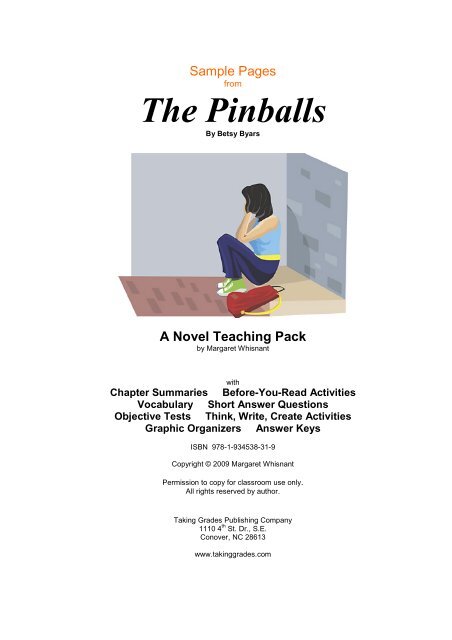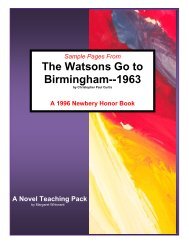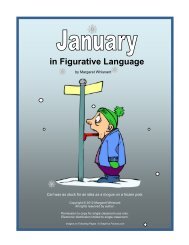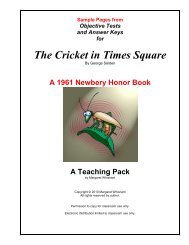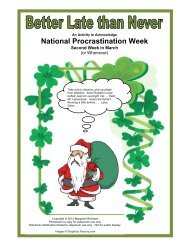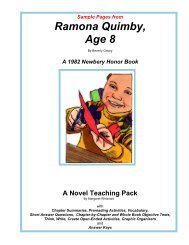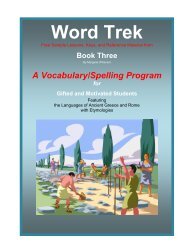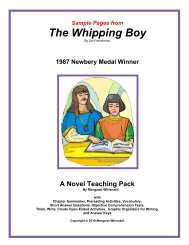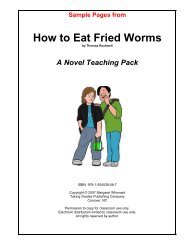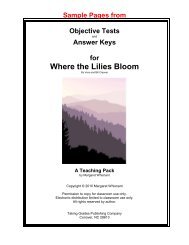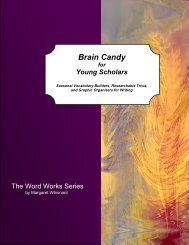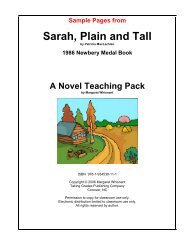The Pinballs - Taking Grades Publishing Company
The Pinballs - Taking Grades Publishing Company
The Pinballs - Taking Grades Publishing Company
Create successful ePaper yourself
Turn your PDF publications into a flip-book with our unique Google optimized e-Paper software.
Sample Pages<br />
from<br />
<strong>The</strong> <strong>Pinballs</strong><br />
By Betsy Byars<br />
A Novel Teaching Pack<br />
by Margaret Whisnant<br />
with<br />
Chapter Summaries Before-You-Read Activities<br />
Vocabulary Short Answer Questions<br />
Objective Tests Think, Write, Create Activities<br />
Graphic Organizers Answer Keys<br />
ISBN 978-1-934538-31-9<br />
Copyright © 2009 Margaret Whisnant<br />
Permission to copy for classroom use only.<br />
All rights reserved by author.<br />
<strong>Taking</strong> <strong>Grades</strong> <strong>Publishing</strong> <strong>Company</strong><br />
1110 4 th St. Dr., S.E.<br />
Conover, NC 28613<br />
www.takinggrades.com
One summer, three children<br />
come to live in a foster home.<br />
Carlie,<br />
angry, intelligent,<br />
TV addict, a comedian,<br />
fighting back.<br />
Harvey,<br />
abandoned, sad,<br />
broken in body, broken in spirit,<br />
losing hope.<br />
Thomas J,<br />
without identity,<br />
without love,<br />
alone,<br />
searching for himself.<br />
Three children,<br />
<strong>The</strong> <strong>Pinballs</strong>,<br />
bounced around by the hand of fate,<br />
needing answers,<br />
needing purpose,<br />
needing each other.<br />
Copyright © 2009 Margaret Whisnant<br />
<strong>Taking</strong> <strong>Grades</strong> <strong>Publishing</strong> <strong>Company</strong>, Conover, NC 2
An Introduction to Your Novel Teaching Pack. . .<br />
Goals<br />
To. . .<br />
• Offer a teaching guide with a full spectrum of learning experiences that flow from basic knowledge to<br />
higher-level thinking skills.<br />
• Provide classroom-ready materials that motivate and instruct.<br />
• Create novel-specific activities that require careful reading, help develop comprehension skills, and<br />
challenge the thinking process.<br />
• Accommodate a wide variety of student ability and interest.<br />
• Support teachers by providing a practical teaching resource that saves preparation time.<br />
• Include cross-curricula activities as an integral part of the novel study.<br />
• Correlate to various state education standards and requirements for language arts.<br />
___________________________________________________________<br />
<strong>The</strong> Seven Components. . .<br />
1. Summaries<br />
Written in present tense, the chapter-by-chapter summaries are more detailed than those found in most<br />
teachers’ guides or other sources. Important points of the plot, character motivation and development, and<br />
story clues are all included. For quick reference, the summaries are presented in bulleted format. <strong>The</strong>se<br />
synopses are a valuable resource for<br />
quickly becoming familiar with a title when time is limited<br />
managing a reading program that involves multiple titles/reading groups<br />
facilitating independent study<br />
refreshing memory when using a novel from year to year.<br />
2. Before You Read<br />
In this component, the focus is on sparking student interest. Each teaching pack includes both an<br />
independent activity and a series of whole-group/small-group discussion or research topics, written as<br />
open-ended questions.<br />
At least one bulletin board idea is included. In some cases, activities in the Think, Write, Create<br />
component also involve the creation of a bulletin board or classroom display.<br />
3. Vocabulary<br />
One of the many advantages of literature-based reading instruction is the opportunity to observe<br />
vocabulary in action! It is this circumstance that drives the vocabulary portion of the novel teaching packs.<br />
Word Choices. . .<br />
<strong>The</strong> words lifted from the novel for focused study are chosen based on one or more of the following<br />
criteria:<br />
their level of difficulty<br />
their importance in comprehending the story<br />
the probability that they will be encountered across<br />
the curriculum<br />
Copyright © 2009 Margaret Whisnant<br />
<strong>Taking</strong> <strong>Grades</strong> <strong>Publishing</strong> <strong>Company</strong>, Conover, NC 3<br />
their frequency of use in children’s literature<br />
their value as useful composition vocabulary<br />
unique meanings, spellings, pronunciation, etc.<br />
Word Lists and Definitions. . .<br />
For teacher convenience and reference, word lists with definitions are included. <strong>The</strong> selected words are<br />
arranged in story order, complete with page numbers so they can be spotted easily and studied in their<br />
“natural habitats.” For clarity, the definitions are paraphrased to match the word’s tense, number, part of<br />
speech, etc. rather than cross referenced as in a standard dictionary. <strong>The</strong> major resource of this information<br />
is www.dictionary.com.<br />
Dictionary Activities. . .<br />
Long word lists are divided into chapter sets of workable numbers and presented as Dictionary Digs—<br />
sometimes given a slightly different name to correspond with the theme of the novel. In this introductory<br />
stage, students use a dictionary to answer a series of multiple choice questions about word meanings, usage,<br />
unique characteristics, etc.
Using the Words. . .<br />
Other activities, which pull terms from the lists in random order, lead students through a variety of word<br />
studies which include<br />
sentence usage<br />
word forms<br />
synonyms and antonyms<br />
anagrams<br />
categories<br />
word groups/connections<br />
Copyright © 2009 Margaret Whisnant<br />
<strong>Taking</strong> <strong>Grades</strong> <strong>Publishing</strong> <strong>Company</strong>, Conover, NC 4<br />
word types (acronyms, onomatopoeia, etc.)<br />
scrambled sentences<br />
analogies<br />
whole-class/group games<br />
etymologies<br />
4. Assessment<br />
<strong>The</strong> two sections in this portion of the teaching pack offer a wealth of materials designed to build a strong foundation<br />
for student progression to higher level thinking skills. <strong>The</strong> operative phrase is basic comprehension.<br />
Short Answer Questions<br />
Short answer questions for each chapter (or groups of chapters) are the first available assessment tools.<br />
<strong>The</strong> items encourage (and check) careful reading. Some require the reader to recognize a major event or<br />
idea while others involve finding a minor detail. <strong>The</strong> questions are in sequence with the pages they cover, but<br />
they are not designed to call attention to plot construction or other story elements.<br />
<strong>The</strong> short answer questions can be used as<br />
student reading guides<br />
pop quizzes<br />
discussion groups guides<br />
conferencing with individual students<br />
Objective Tests<br />
<strong>The</strong> objective tests have multiple functions. In addition to their obvious application, they also serve as<br />
tools that can improve comprehension skills by providing practice in understanding plot structure and<br />
recognizing important story elements.<br />
Rationale:<br />
Focus on the Plot. . .<br />
Whether they are aware of their ability or not, all good readers sense the rhythm of the connected<br />
events that compose the plot of a novel, and consequently comprehend the story. <strong>The</strong>y are in tune with<br />
cause and effect, behavior and consequence, sequence—the heartbeat of the narrative.<br />
This “plot rhythm” forms the framework for the objective tests. <strong>The</strong> chain of events that tell the story have<br />
been pulled from the novel and reformatted into a series of sequential questions, none of which require<br />
interpretation. <strong>The</strong>y are intended to draw student attention to the fact that something happened, not to<br />
what the incident means. That comes later.<br />
In addition to their testing function, teachers may use the pages to strengthen their students’ ability to<br />
Summarize: With only the questions as a guide, have students write a summary of the chapter. For a set of<br />
ten questions, limit the number of sentences they may write to seven or fewer. When they work with twenty<br />
or more questions, allow no more than twelve sentences.<br />
Report the News: Ask your students to write a newspaper article based on the events identified in a set of<br />
questions and the who, what, when, where, why elements. Some information needed to complete this<br />
assignment may be located in previous chapters.<br />
Twist the Plot: Choose one or two questions from each chapter and change its answer—true to false, no to<br />
yes, etc.—to demonstrate how changing a single (or several) events would (or would not) change the story.<br />
This process can be used to help students become proficient in distinguishing major plot movers from minor<br />
story details.<br />
<strong>The</strong> Characters. . .<br />
Too often, when they are asked to describe a story character’s personality, the only answer many<br />
students can muster is “nice.” This portion of the Novel Teaching Pack, coupled with related activities from<br />
Think, Write, Create, is a well of opportunities for those teachers who wish to eradicate “nice” from their<br />
students’ vocabularies!<br />
Questions that identify a character’s personality and/or motivation are purposely and carefully included<br />
with the plot movers. Again, the questions do not require interpretation. <strong>The</strong>y simply establish that<br />
someone did or said something—knowledge that is invaluable when character analysis is required.
Implied Meaning and Story Clues. . .<br />
<strong>The</strong> objective tests include items that establish the existence of story components carrying implied<br />
meaning. Story clues that tantalize the reader with hints of future events also appear as question. At this<br />
point in the novel study, as before, interpretation is not the goal. Awareness of the facts is the target.<br />
Developing/Improving Listening Skills. . .<br />
Listening skills are rightfully included on every list of state competency requirements. Rather than always<br />
requiring students to answer test questions on a printed page, why not surprise them occasionally by doing<br />
the test orally and meeting competency goals at the same time?<br />
Discussion Guide Capability. . .<br />
<strong>The</strong> objective tests are helpful discussion guides. Use individual items on these pages to draw student<br />
attention to sequence, cause and effect, story clues (foreshadowing), character traits, recognizing and<br />
interpreting implied meanings, etc. <strong>The</strong>se “thinking out loud” sessions are an important building block for<br />
the next learning phase.<br />
5. Think, Write, Create<br />
In this section, students pack up what they already know about the novel and go exploring into its every<br />
nook and cranny. Some activities require the simplest interpretation or application, while others will challenge<br />
the most proficient thinkers. <strong>The</strong>re is a high probability that young scholars, even reluctant ones, will label<br />
some of the selections as fun.<br />
Rationale:<br />
Guidelines. . .<br />
Most of the items in this section are based on the skills presented in the Taxonomy of Educational<br />
Objectives (Bloom’s Taxonomy). <strong>The</strong>re are two reasons for this choice. First, it mirrors the Novel<br />
Teaching Pack’s primary purpose of building a variety of sophisticated thinking skills on a foundation of basic<br />
knowledge. Second, in following the taxonomy guidelines, activities that correlate with many state<br />
educational standards emerge automatically.<br />
Organization. . .<br />
Chapter-specific activities are grouped and presented according to their corresponding sets of Short<br />
Answer Questions and Objective Test page(s). Having led students through the basics for each chapter (or<br />
selected section), teachers may shop in this section for in-depth activities to optimize student understanding<br />
and interest. Armed with a firm grasp of each successive chapter, students are more likely to anticipate,<br />
embrace, and enjoy the next section. By repeating the process, students are also mastering concepts and<br />
intricacies connected to the whole novel<br />
<strong>The</strong> Whole Book Activities, as their name indicates, require a grasp of the theme(s), characters,<br />
implications, etc. as they apply to the full novel. <strong>The</strong>se pages are a teacher’s smorgasbord of culminating<br />
possibilities. In some cases, the choices are outgrowths of concepts that students have dealt with in a<br />
previous activity. In others, students are encouraged to look at the novel from a new angle.<br />
Levels of Difficulty. . .<br />
A broad spectrum of difficulty levels to accommodate the needs of individual students, including the<br />
gifted, is an integral part of Think, Write, Create. However, all items from this section are intended to<br />
challenge and sharpen thinking abilities.<br />
Activities. . .<br />
Every novel teaching pack includes activities that require students to choose and use precise, appropriate,<br />
and meaningful vocabulary. <strong>The</strong>se exercises involve choosing a group of words to describe a character’s<br />
personality or behavior. <strong>The</strong> following example is from Charlotte’s Web.<br />
Eight-year-old Fern cried and begged her father not to destroy the runt pig. She sealed the little animal’s fate by<br />
asking her father if he would have killed her if she had been born very small.<br />
• Which two of the following words do you think best describe the way Fern’s father behaved during this episode?<br />
Explain your choice. Include the definitions of the words you selected in your answer.<br />
practical sensitive loving cruel considerate<br />
realistic flexible callous compassionate logical<br />
• Choose two words from the list below that you believe best describe Fern’s behavior. Explain why they are<br />
the appropriate words. Use the definitions of your choices as part of your explanation.<br />
impulsive compassionate assertive tender-hearted hysterical<br />
undisciplined naive juvenile humane empathetic<br />
Copyright © 2009 Margaret Whisnant<br />
<strong>Taking</strong> <strong>Grades</strong> <strong>Publishing</strong> <strong>Company</strong>, Conover, NC 5
In each case students work with a given collection of terms, all of which can be correctly applied to the<br />
character(s) in question. However, the individual words have strengths of meaning. It is the student’s task to<br />
analyze both the character’s behavior and the words, make choices, and then cite events from the story to<br />
support his/her selection.<br />
Teachers may opt to narrow the choices to fewer words, choose words for individual students, divide the<br />
class into groups and offer a specific set of words to each group, or use the assignment as it is written.<br />
Whatever the technique, it is here that the word nice can be knocked off the shelf, shattered on the floor, and<br />
swept out the door. No longer necessary. Useless. Gone!<br />
Other items in this section challenge students to . . .<br />
write for self-expression, for communication, and think bout social issues<br />
for entertainment create drawings, diagrams, photos, maps,<br />
form opinions and theories models, recordings, films, etc.<br />
cite “evidence” from the story to support their imagine<br />
explanations and opinions categorize<br />
connect personal experience to story situations engage in research and data gathering<br />
become familiar with and identify literary elements recognize and perceive story theme(s)<br />
analyze story characters and events understand point of view<br />
make predictions based on given facts<br />
Cross Curricula. . .<br />
Think, Write, Create takes full advantage of opportunities to connect both major themes and the smallest<br />
story detail to other realms of the curriculum. In Charlotte’s Web, for example, students may apply their<br />
calculation skills to a page of “Spider Math.” In the Holes teaching pack is a challenge to create a game that<br />
utilizes a “saved” group of Camp Green Lake’s holes.<br />
Options, options, and more options. . .<br />
Think, Write, Create is purposely bulging at the seams to give teachers pick-and-choose options for<br />
individualizing assignments homework<br />
group work short-term and long-term projects<br />
whole class activities differentiating assignments for two or more classes<br />
capitalizing on student interest<br />
6. Graphic Organizers<br />
Ideas for the graphic organizers are pulled from the chapter or whole book activities and expanded into a<br />
writing assignment. Priority is given to those topics that allow a student to relate personal experiences, make<br />
choices, empathize with a story character, and/or imagine.<br />
Structure. . .<br />
<strong>The</strong> organizers do not repeat a set pattern of circles, squares, lines, etc., prescribed for a particular type of<br />
writing. Each one is tailored to a specific idea pulled from the novel. Structured directions for organizing<br />
the topic support the student at this stage of the process so that writing is the major focus.<br />
Non-writing Organizers. . .<br />
Sometimes, students are enticed to stretch their imaginations by filling out “forms” or writing “diary entries.”<br />
One graphic organizer from Hatchet, for example, allows students to assume the persona of the pilot who<br />
rescued Brian by writing three entries into his log—the day before the rescue, the day of the rescue, and the<br />
day after the rescue. In the Holes Novel Teaching Pack, students become detectives and conduct a<br />
“background check” on Mr. Sir, recording their findings on the provided “official form.” In these cases,<br />
composition skills take a back seat to imagination, empathy, and pure enjoyment. Teachers may wish to<br />
capitalize on student enthusiasm by asking for a written “report” based on the information entered on the<br />
forms.<br />
7. Answer Keys<br />
Keys for all items that require a specific answer are included in this section.<br />
___________________________________________________________<br />
A final note from the author. . .<br />
It is my personal wish that when the last page has been read, the last activity completed, and the last idea<br />
discussed, at least one of your students will ask, “What are we going to read next?”<br />
Copyright © 2009 Margaret Whisnant<br />
<strong>Taking</strong> <strong>Grades</strong> <strong>Publishing</strong> <strong>Company</strong>, Conover, NC 6<br />
Margaret Whisnant
<strong>The</strong> <strong>Pinballs</strong><br />
By Betsy Byars<br />
A Novel Teaching Pack<br />
Table of Contents<br />
Copyright © 2009 Margaret Whisnant<br />
<strong>Taking</strong> <strong>Grades</strong> <strong>Publishing</strong> <strong>Company</strong>, Conover, NC 1<br />
Page(s)<br />
Chapter Summaries . . . . . . . . . . . . . . . . . . . . . . . . . . . . . . . . . . . . . . . . . . .. . . . . . . 1-16<br />
Before You Read<br />
Carlie’s TV Trivia . . . . . . . . . . . . . . . . . . . . . . . . . . . . . . . . . . . . . . . . . . . . . . . . . . 17-18<br />
Something to Think About/Research/Bulletin Board Ideas . . . . . . . . . . . . . . . . . . . 19-20<br />
Vocabulary<br />
Vocabulary List in Alphabetical Order . . . . . . . . . . . . . . . . . . . . . . . . . . . . . . . . . . . . . 21<br />
Vocabulary Lists with Definitions . . . . . . . . . . . . . . . . . . . . . . . . . . . . . . . . . . . . . . 22-23<br />
Dictionary Digs . . . . . . . . . . . . . . . . . . . . . . . . . . . . . . . . . . . . . . . . . . . . . . . . . . . .24-27<br />
Anagram Scramble . . . . . . . . . . . . . . . . . . . . . . . . . . . . . . . . . . . . . . . . . . . . . . . . .28-29<br />
Word Families . . . . . . . . . . . . . . . . . . . . . . . . . . . . . . . . . . . . . . . . . . . . . . . . . . . . . . . 30<br />
Short Answer Questions . . . . . . . . . . . . . . . . . . . . . . . . . . . . . . . . . . . . . . . . . . . .31-34<br />
Objective Tests<br />
Chapter Tests<br />
Chapter 1—Chapter 2. . . . . . . . . . . . . . . . . . . . . . . . . . . . . . . . . . . . . . . . . . . . . . . . . . .. . . . . .35<br />
Chapter 3—Chapter 4. . . . . . . . . . . . . . . . . . . . . . . . . . . . . . . . . . . . . . . . . . . . . . . . . . . . . .36-37<br />
Chapter 5—Chapter 6 . . . . . . . . . . . . . . . . . . . . . . . . . . . . . . . . . . . . . . . . . . . . . . . . . . . . . . . .38<br />
Chapter 7—Chapter 8 . . . . . . . . . . . . . . . . . . . . . . . . . . . . . . . . . . . . . . . . . . . . . . . . . . . . . . . .39<br />
Chapter 9—Chapter 10 . . . . . . . . . . . . . . . . . . . . . . . . . . . . . . . . . . . . . . . . . . . . . . . . . . . .40-41<br />
Chapter 11—Chapter 12 . . . . . . . . . . . . . . . . . . . . . . . . . . . . . . . . . . . . . . . . . . . . . . . . . . 42-43<br />
Chapter 13—Chapter 14 . . . . . . . . . . . . . . . . . . . . . . . . . . . . . . . . . . . . . . . . . . . . . . . . . . 44-45<br />
Chapter 15.—Chapter 16 . . . . . . . . . . . . . . . . . . . . . . . . . . . . . . . . . . . . . . . . . . . . . . . . . . .46-47<br />
Chapter 17—Chapter 18 . . . . . . . . . . . . . . . . . . . . . . . . . . . . . . . . . . . . . . . . . . . . . . . . . . 48-49
Table of Contents—continued<br />
Chapter 19—Chapter 20—Chapter 21. . . . . . . . . . . . . . . . . . . . . . . . . . . . . . . . . . . . . . 50-51<br />
Chapter 22—Chapter 23 . . . . . . . . . . . . . . . . . . . . . . . . . . . . . . . . . . . . . . . . . . . . . . . . . . . 52<br />
Chapter 24—Chapter 25—Chapter 26 . . . . . . . . . . . . . . . . . . . . . . . . . . . . . . . . . . . . . .53-54<br />
Whole Book Test . . . . . . . . . . . . . . . . . . . . . . . . . . . . . . . . . . . . . . . . . . . . . . . . . . . .55-56<br />
Think, Write, Create<br />
Chapter-by-Chapter . . . . . . . . . . . . . . . . . . . . . . . . . . . . . . . . . . . . . . . . . . . . . .57-70<br />
Whole Book . . . . . . . . . . . . . . . . . . . . . . . . . . . . . . . . . . . . . . . . . . . . . . . . . . . 71-75<br />
Graphic Organizers<br />
Three Children . . . . . . . . . . . . . . . . . . . . . . . . . . . . . . . . . . . . . . . . . . . . . . . . . . . .76<br />
How to Mind Your Own Business When Everything You Are<br />
Interested in Is Your Business . . . . . . . . . . . . . . . . . . . . . . . . . . . .77<br />
<strong>The</strong> Awesome Twosome . . . . . . . . . . . . . . . . . . . . . . . . . . . . . . . . . . . . . . . . . . . 78<br />
A Successful Gift . . . . . . . . . . . . . . . . . . . . . . . . . . . . . . . . . . . . . . . . . . . . . . . . 79<br />
Carlie and Thomas J’s Really Nice Birthday . . . . . . . . . . . . . . . . . . . . . . . . . . . .80<br />
Mr. and Mrs. Mason, Foster Parents Extraordinaire . . . . . . . . . . . . . . . . . . . . . .81<br />
Thomas J’s Fifteen Minutes of Fame—A Scenario . . . . . . . . . . . . . . . . . . . . . . .82<br />
<strong>The</strong> Eccentric Benson Twins . . . . . . . . . . . . . . . . . . . . . . . . . . . . . . . . . . . . . . . .83<br />
Carlie’s Transformation: A Study of “I’ll Be Glad To.” . . . . . . . . . . . . . . . . . . . . .84<br />
Harvey’s Best Sellers . . . . . . . . . . . . . . . . . . . . . . . . . . . . . . . . . . . . . . . . . . . . . 85<br />
Keys. . . . . . . . . . . . . . . . . . . . . . . . . . . . . . . . . . . . . . . . . . . . . . . . . . . . . . . . . . . . . . . . . 86-91<br />
Copyright © 2009 Margaret Whisnant<br />
<strong>Taking</strong> <strong>Grades</strong> <strong>Publishing</strong> <strong>Company</strong>, Conover, NC 2
Summaries <strong>The</strong> <strong>Pinballs</strong><br />
By Betsy Byars<br />
1<br />
2<br />
Chapter Summaries<br />
• One summer two boys and a girl go to a foster home to live together.<br />
• One of the boys is Harvey. Both of his legs are broken because his father ran over him with<br />
a car.<br />
• When Harvey wins third prize of two dollars for his essay, “Why I Am Proud to Be an<br />
American,” his father promises to drive him to the meeting to see him get the award.<br />
<strong>The</strong> winners and their parents will have their pictures in the newspaper.<br />
• On the night of the awards, Harvey sits waiting in the car for his father. He cannot believe it<br />
when the man tells him to get out of the car. He is late for his poker game at the Elks Club.<br />
• Harvey reminds his father of his promise, but the man denies having promised Harvey<br />
anything. He leans over and pushes his son out of the car. When Harvey grabs for the car<br />
door, the red-faced man locks it.<br />
• Harvey runs around the front of the car to try to open the other door. His father accidentally<br />
throws the car into drive instead of reverse and steps on the gas. <strong>The</strong> Trans Am runs over<br />
Harvey and breaks both his legs.<br />
• <strong>The</strong> court takes Harvey away from his father and puts him in the foster home until his father<br />
can control his drinking and give the boy a safe home.<br />
• <strong>The</strong> second boy is Thomas J. He doesn’t know anything about his family. At the age of two,<br />
he had been dropped off in front of the Benson twins’ farmhouse. <strong>The</strong>y are eighty-two years<br />
old, and the oldest twins in the state. Thomas J stays with them for six years.<br />
• <strong>The</strong> Bensons mean to take Thomas J to town to the authorities, but he is pleasant company.<br />
He is also good help in the garden. When the twins both fall and break their hips at the age<br />
of eighty-eight, the authorities discover Thomas J. He is sent to the foster home until his<br />
identity can be established or permanent adoptive parents can be found.<br />
• <strong>The</strong> girl is Carlie. She never says anything polite. She throws things at people who block<br />
her view when she is watching television, which is her main fun.<br />
• Carlie has had two stepfathers, but Russell is the worst. She has been sent to the foster<br />
home because she can’t get along with him.<br />
• Once Russell hit Carlie so hard, she got a concussion. Before she collapsed, she had<br />
managed to hit him back with a double boiler. She has to stay at the foster home until her<br />
own home situation stabilizes.<br />
• <strong>The</strong> first thing Carlie does at the Masons’ is pull the plastic footrest up close to the TV and<br />
warn Mrs. Mason not to talk to her when “Young and Restless” is on. Her foster mother can<br />
welcome her during the commercial.<br />
• Carlie has been suspicious of people since the day she was born. She believes everyone is<br />
out to do her in. She dislikes Mrs. Mason, the foster mother, as soon as she sees her<br />
standing in the doorway. She tells the social worker that the woman is trying to copy Mrs.<br />
Walton (Note: character from 1971-1981 TV series “<strong>The</strong> Waltons”) by wearing an apron, but<br />
she is not fooled by such things.<br />
• Carlie is especially disturbed by the Masons’ living room, where there are seventeen<br />
pictures, probably of foster children. Carlie vows that her picture will not go up over the<br />
fireplace with the others.<br />
• Mrs. Mason waits until “Young and Restless” is over to ask Carlie to come have some<br />
lunch. Afterwards, they will get the boys’ room ready. Carlie is interested.<br />
• <strong>The</strong> boys are eight and thirteen—too young for Carlie. Mrs. Mason says the boys will have<br />
to tell Carlie about their troubles. All she knows is that the thirteen-year-old has two broken<br />
legs.<br />
• Carlie says that lets out dancing.<br />
___________________________________________________________<br />
Copyright © 2009 Margaret Whisnant<br />
<strong>Taking</strong> <strong>Grades</strong> <strong>Publishing</strong> <strong>Company</strong>, Conover, NC 1
Vocabulary <strong>The</strong> <strong>Pinballs</strong><br />
By Betsy Byars<br />
abandoned (p. 56)<br />
abruptly (p. 23, 81, 135)<br />
addicted (p. 45)<br />
admiration (p. 133)<br />
agonized (p. 101)<br />
astonished (p. 71)<br />
authorities (p. 5)<br />
blurt (p. 125)<br />
boutique (p. 43)<br />
cahoots (p. 114)<br />
casserole (p. 69)<br />
clenched (p. 25, 57, 74)<br />
collapsed (p. 6)<br />
commotion p. 120)<br />
commune (p. 24)<br />
concentrate (p. 40)<br />
concussion (p. 6)<br />
criticized (p. 69)<br />
crouched (p. 25)<br />
crumpled (p. 35)<br />
feeble (p. 94)<br />
fetching (p. 18)<br />
fidget (p. 74)<br />
forge (p. 12)<br />
foster (p. 3)<br />
furious (p. 113)<br />
gnarled (p. 25)<br />
hacking (p. 129)<br />
hesitated (p. 23, 81)<br />
hovered (p. 35)<br />
Vocabulary List in<br />
Alphabetical Order<br />
Some words may appear on pages other than those indicated.<br />
Copyright © 2009 Margaret Whisnant<br />
<strong>Taking</strong> <strong>Grades</strong> <strong>Publishing</strong> <strong>Company</strong>, Conover, NC 2<br />
hunched (p. 84)<br />
identity (p. 5, 25)<br />
juvenile (p. 78)<br />
lose (p. 18)<br />
lunged (p. 11)<br />
majorette (p. 37)<br />
mugged (p. 65)<br />
mutely (p. 95)<br />
nudged (p. 108, 118)<br />
peering (p. 25)<br />
persuaded (p. 63)<br />
pester (p. 36)<br />
principle (p. 60)<br />
rave (p. 30)<br />
resented (p. 6)<br />
scraggly (p. 18)<br />
snubbed (p. 134)<br />
shriveled (p. 55)<br />
stabilizes (p. 6)<br />
startled (p. 38, 100)<br />
sulked (p.69, 93)<br />
summoned (p. 41)<br />
superior (p. 33)<br />
suspicious (p. 9)<br />
technique (p. 17)<br />
tottering (p. 52)<br />
twinge (p. 15)<br />
uncomplimentary (p. 129)<br />
vaccine (p. 20)<br />
wavered (p. 93)
Vocabulary <strong>The</strong> <strong>Pinballs</strong><br />
By Betsy Byars<br />
Vocabulary Lists with Definitions<br />
Set One: Chapter 1—Chapter 7<br />
(30 words) Some words may appear on more than one page.<br />
foster To feed, nourish, nurture, bring up, or support, as a child in need of parental care; to cherish;<br />
to promote the growth of; to encourage;. (p. 3)<br />
authorities Persons having the legal power to make and enforce the law; the government;. (p. 5)<br />
identity <strong>The</strong> condition of being oneself or itself, and not another; who a person or what a thing is,<br />
such as that defined by genetic kinship or relationships . (p. 5)<br />
resented Disliked; bore a grudge against, felt or showed displeasure, anger, or offense at a<br />
person, a remark, or act, etc. because of a sense of injury of insult. (p. 6)<br />
concussion Injury to the brain or spinal cord due to jarring from a blow, fall, or the like, and<br />
followed by a temporary or prolonged loss of function; a violent jarring; a shock caused<br />
by the collision of two objects (p. 6)<br />
collapsed Fell down or inward suddenly; caved in. (p. 6)<br />
stabilizes Maintains at a given level or quality without changing; balances; equalizes. (p. 6)<br />
suspicious Distrustful; the act of believing something, especially wrong doing, on little evidence or<br />
entirely without proof; cautious; doubtful; skeptical. (p. 9)<br />
lunged Moved forward suddenly, as to attack; jumped; charged; sprang. (p. 11)<br />
forge To imitate handwriting, a signature, etc. fraudulently; faked; to move ahead slowly and<br />
steadily; to move ahead with increased speed and efficiency. (p. 12)<br />
twinge A sudden, sharp pain; a mental or emotional pang. (p. 15)<br />
technique <strong>The</strong> manner in which something is accomplished; technical skill; ability to apply<br />
procedures or methods so as to effect a desired result; craft; capability. (p. 17)<br />
lose To come to be without; to be unsuccessful in retaining possession of; mislay (p. 18) Compare<br />
with loose Free or released from fastening or attachment; not tight.<br />
fetching Coming or going after and taking or bringing back; charming or captivating; attractive;<br />
pleasing to the eye; bringing in as a price. (p. 18)<br />
scraggly Shaggy; irregular; unkempt; uneven. (p. 18)<br />
vaccine A substance prepared from dead or living microorganisms that is introduced into the body<br />
through inoculation (a shot) and causes the development of antibodies, which produce<br />
immunity to the disease caused by the microorganism. (p. 20)<br />
hesitated Waited to act because of fear or indecision; paused; faltered in speech; stammered;<br />
balked; delayed; pondered; thought about. (p. 23, 81)<br />
abruptly Suddenly or unexpectedly; in a manner than is rude or brief; curtly; brusquely. (p. 23)<br />
commune A small group of persons living together and sharing work, possessions, income, etc.,<br />
and often pursuing unconventional lifestyles; to talk together, with profound intensity<br />
concerning one’s thoughts or feelings; to be in intimate communication or rapport with,<br />
as nature. (p. 24)<br />
crouched Stooped, especially with the knees bent; stooped low; huddled; stooped.( p. 25)<br />
peering Looking at intently, searchingly, or with difficulty; being partially visible; gazing. (p. 25)<br />
gnarled Twisted; bent; snarling; growling; distorted; deformed. (p. 25)<br />
clenched Closed or squeezed together tightly; clamped; constricted. (p. 25)<br />
rave To talk wildly, as if delirious; to roar; rage; to speak or write with wild enthusiasm. (p. 30)<br />
superior Showing an attitude or feeling of being better than or above another. higher than another<br />
in rank, station, or authority; of a higher nature or kind; excellent; first-rate. (p. 33)<br />
crumpled Crushed; pressed or crushed into irregular folds or into a compact mass; bent out of<br />
shape; gave way suddenly, as confidence. (p. 35)<br />
hovered Remained or lingered in or near a place; remained floating, suspended, or fluttering in the<br />
air; floated; lingered. (p. 35)<br />
pester Annoy; to bother persistently with petty annoyances; harass; bother; badger; hassle. (p. 36)<br />
majorette A female baton twirler who accompanies a marching band. (p. 37)<br />
startled Surprised; suddenly shocked or alarm; frightened; stunned. (p. 38)<br />
Copyright © 2008 Margaret Whisnant<br />
<strong>Taking</strong> <strong>Grades</strong> <strong>Publishing</strong> <strong>Company</strong>, Conover, NC 28613 3
Vocabulary <strong>The</strong> <strong>Pinballs</strong><br />
By Betsy Byars<br />
Dictionary Digs<br />
Chapter 1—Chapter 7<br />
Dig into your favorite dictionary to answer the following questions about some important words from<br />
Chapters 1 through 7 of <strong>The</strong> <strong>Pinballs</strong>. Write the letters of the correct answers in the blanks to the left.<br />
______1. A synonym for hesitated is (A) faltered, (B) surged, (C) resolved.<br />
______2. Which of the following phrases is not a good example of the correct use of the word<br />
forge? (A) forge a signature, (B) forge through a mountain of homework, (C) forge a<br />
song for his own entertainment.<br />
______3. <strong>The</strong> correct spelling of the word meaning to come to be without is (A) loose, (B) lose,<br />
(C) louse.<br />
______4. Which word can be substituted for resented in the following sentence so that it is<br />
changed to an opposite meaning?<br />
Isaiah stood expressionless, trying to hide the fact that he resented<br />
every word Mrs. Nieman spoke.<br />
(A) savored, (B) begrudged, (C) disdained<br />
______5. To say that someone has a superior attitude means that the person (A) fancies himself<br />
to be better than another or others, (B) has a healthy self-esteem, (C) doesn’t care.<br />
______6. Something not likely to have hovered in midair is (A) a UFO, (B) a hummingbird, (C) a<br />
fast-pitched softball.<br />
______7. A majorette is (A) a male drummer in a marching band, (B) a female baton twirler who<br />
accompanies a marching band, (C) any uniformed member of a marching band.<br />
______8. Which of the following caricatures is the best example of a facial expression that could be<br />
interpreted as suspicious?<br />
(A) (B) (C)<br />
______9. A word that is an antonym of stabilizes is (A) equalizes, (B) varies, (C) balances.<br />
_____10. An incorrect definition of the word commune is (A) to begin on schedule, especially a<br />
vital undertaking, (B) to talk together, (C) a small group of people living together and<br />
sharing work, possessions, income, etc.<br />
_____11. A tiger is most likely to be in a crouched position when it is (A) sleeping, (B) hunting,<br />
(C) running.<br />
_____12. <strong>The</strong> authorities are people who (A) have legal power to make and/or enforce the law,<br />
(B) carry out search and rescue, (C) make rules and decisions for corporations.<br />
_____13. If Mr. James has decided to foster the idea of creating a neighborhood playground, then<br />
he will (A) try to stop the project, (B) support and encourage the idea, (C) not take sides.<br />
_____14. <strong>The</strong> purpose of a vaccine is to (A) cure disease, (B) provide immunity and prevent<br />
disease, (C) gather information about certain infectious diseases.<br />
Copyright © 2008 Margaret Whisnant<br />
<strong>Taking</strong> <strong>Grades</strong> <strong>Publishing</strong> <strong>Company</strong>, Conover, NC 28613 4
Vocabulary <strong>The</strong> <strong>Pinballs</strong><br />
By Betsy Byars<br />
Anagram Scramble<br />
(anagram A word, phrase, or sentence formed by rearranging the letters of another word, phrase or<br />
sentence. Rest of is an anagram for foster, for example.)<br />
Use the clues to descramble the anagrams and identify the vocabulary words from <strong>The</strong> <strong>Pinballs</strong>. Write<br />
the words in the blanks to the left. Spelling counts!<br />
Answers Anagrams Clues<br />
_____________________1. red couch Begin with a scarlet sofa and transform it into<br />
stooped low, especially with the knees bent.<br />
_____________________2. She said not. Shuffle a negative comment until it becomes<br />
filled with sudden wonder or amazement.<br />
_____________________3. dug den Change what the badger did into pushed slightly<br />
or gently, especially with the elbow.<br />
_____________________4. bend bus Rearrange the command to contort a mass-<br />
transit vehicle until it means ignored or behaved<br />
coldly toward.<br />
_____________________5. concrete ant Start with a cement insect and end with to direct<br />
one’s thoughts or attention to.<br />
_____________________6. a done band Take a washed-up group of musicians and<br />
restructure it into left alone or deserted.<br />
_____________________7. wig net Work with an instrument for catching a hair piece<br />
until it becomes a sudden, sharp pain.<br />
_____________________8. my lute Transform your stringed musical instrument<br />
from the renaissance into a state of not<br />
emitting or having sound of any kind.<br />
_____________________9. elf bee Prove that an insect transport for wee folks is<br />
also lacking in strength, force,<br />
or effectiveness.<br />
____________________10. It is tea hour. What word can change<br />
an afternoon break<br />
into people having<br />
the legal power to make and<br />
enforce the law?<br />
____________________11. vile herds Begin with offensive groups of animals and end<br />
with shrunken and wrinkled, as from a lack of<br />
moisture.<br />
____________________12. comment ruin play Change the utterance that destroyed the<br />
performance into a kindred word that means not<br />
favorable or appreciative.<br />
____________________13. red clump Examine a blushing glob and prove that it is also<br />
pressed or crushed into irregular folds or into a<br />
compact mass.<br />
____________________14. He drove. Revise the fact that a male controlled the vehicle<br />
so that it means remained floating, suspended,<br />
or fluttering in the air.<br />
____________________15. Men do sum. Adjust the calculating males and create sent for;<br />
requested to appear.<br />
Copyright © 2008 Margaret Whisnant<br />
<strong>Taking</strong> <strong>Grades</strong> <strong>Publishing</strong> <strong>Company</strong>, Conover, NC 28613 5
Assessment <strong>The</strong> <strong>Pinballs</strong><br />
By Betsy Byars<br />
Short Answer Questions<br />
Chapter 1-Chapter 2<br />
1. What time of the year was it when Harvey, Carlie, and Thomas J went to live with the Masons?<br />
2. On the day of his accident, why had Harvey sat in the car waiting for his father?<br />
3. Explain why Harvey was in front of his father’s Grand Am when it lunged forward.<br />
4. How old was Thomas J when someone left him in front of the Benson Twins’ farmhouse?<br />
5. What event led to Thomas J’s being discovered by the authorities?<br />
6. What did Carlie think about other people and how did she treat them?<br />
7. How did Carlie’s stepfather Russell treat her?<br />
8. What did Carlie say about the collection of photographs that were displayed over the fireplace?<br />
9. What was Carlie doing when Harvey arrived?<br />
10. How did Harvey explain his broken legs to Carlie?<br />
Chapter 3—Chapter 4<br />
1. Why did Thomas J yell everything he said?<br />
2. What was Mrs. Mason’s reason for putting Thomas J and Harvey in the same room?<br />
3. Summarize the event that had sent both of the Benson twins to the hospital.<br />
4. What facts did Thomas J learn for the first time when the Benson twins were admitted to the<br />
hospital?<br />
5. Until Carlie had come to the foster home, what had her sleeping accommodations been like?<br />
6. Where did Thomas J find the earring that Carlie said someone had stolen?<br />
7. Explain the reason Thomas J wanted the Benson twins to keep losing their father’s gold watch<br />
so he could keep finding it.<br />
8. Rather than thanking Thomas J for finding her earring, what did Carlie do?<br />
9. How did Mrs. Mason know that the first night in a foster home was always the hardest?<br />
10. What did Carlie think she could always do if things weren’t better the next day.<br />
Chapter 5—Chapter 6<br />
1. How long had it been since Harvey had seen his mother?<br />
2. What was the reason Harvey’s mother wanted to move to Virginia and live in a commune with<br />
nineteen other people?<br />
3. Where was Harvey when his parents had their last terrible quarrel?<br />
4. What had Harvey’s father done when he saw the picture of his wife and some of the other<br />
people on the Virginia farm in the New York Times Magazine?<br />
5. Why didn’t Harvey get out of bed the next morning?<br />
6. Who delivered Harvey’s breakfast tray?<br />
7. Why did Carlie tell Harvey he was hopeless?<br />
8. Explain why Carlie felt bad when Harvey thanked her for bringing his breakfast?<br />
9. What was Carlie’s explanation as to why she was not the person to help Harvey?<br />
10. Why did Harvey wish his father could have overheard the conversation between Carlie and<br />
Mrs. Mason?<br />
Chapter 7—Chapter 8<br />
1. What promise did Carlie make in the letter she wrote to her mother?<br />
2. Why had the police been at the hospital with Harvey and his father?<br />
3. What was the only thing that Thomas J could think of to say to the Benson twins in his letter to<br />
them?<br />
4. What was the title of Harvey’s first list about himself?<br />
Copyright © 2008 Margaret Whisnant<br />
<strong>Taking</strong> <strong>Grades</strong> <strong>Publishing</strong> <strong>Company</strong>, Conover, NC 28613 6
Assessment <strong>The</strong> <strong>Pinballs</strong><br />
Objective Tests By Betsy Byars<br />
Chapter 1 and Chapter 2<br />
Pages 3-12<br />
Write either True or False in the blank before each statement.<br />
___________1. It was summer when the three children<br />
came to the foster home.<br />
___________2. Harvey had expected his father to drive<br />
him to a meeting where he was to receive<br />
an award for winning third prize in an<br />
essay contest.<br />
___________3. <strong>The</strong> night of the accident, Harvey’s father<br />
had pushed him out of the car and locked the door.<br />
___________4. Harvey’s legs had been broken when he fell trying to run from his angry<br />
father.<br />
___________5. Harvey's father had a drinking problem.<br />
___________6. <strong>The</strong> Benson twins were Thomas J’s great-aunts.<br />
___________7. <strong>The</strong> Benson twins were eighty-eight years old, and Thomas J had lived<br />
with them for six years.<br />
___________8. Thomas J came to the foster home because both the twins fell and<br />
broke their hips.<br />
___________9. Carlie always had something kind and pleasant to say to everybody.<br />
__________10. Watching television was Carlie’s main fun.<br />
__________11. Carlie came to the foster home because her stepfather had hit her so<br />
hard she had gotten a concussion.<br />
__________12. <strong>The</strong> first thing Carlie did in the foster home was pull a plastic footrest<br />
close to the television and watch “Young and Restless.”<br />
__________13. Carlie usually liked and trusted everyone she met.<br />
__________14. Carlie felt better about her situation when she saw the pictures of the<br />
Masons’ seventeen foster children displayed over the fireplace.<br />
__________15. Thomas J was eight years old and Harvey was thirteen.<br />
__________16. Harvey was in a wheelchair.<br />
__________17. Carlie was watching television when she and Harvey first met.<br />
__________18. Harvey told Carlie he had been injured playing quarterback in a football<br />
game.<br />
__________19. Harvey's casts were covered with autographs.<br />
__________20. Carlie believed Harvey's story about how he had been injured.<br />
Copyright © 2008 Margaret Whisnant<br />
<strong>Taking</strong> <strong>Grades</strong> <strong>Publishing</strong> <strong>Company</strong>, Conover, NC 28613 7
Assessment <strong>The</strong> <strong>Pinballs</strong><br />
Objective Tests By Betsy Byars<br />
Chapter 3 and Chapter 4<br />
Pages 13-21<br />
Write the letter of the correct answer in the blank before each question.<br />
______1. Why did Thomas J yell when he talked? (A) <strong>The</strong> Benson<br />
twins were almost deaf, and he had to yell to be heard.<br />
(B) He was angry with everyone. (C) He was hard of<br />
hearing.<br />
______2. Mrs. Mason put Thomas J and Harvey in the same room<br />
(A) because there wasn’t another bedroom in the house,<br />
(B) because she knew Thomas J was terrified of sleeping<br />
in a room by himself, (C) so Thomas J could help Harvey<br />
if he needed it.<br />
______3. Watching “Tony Orlando and Dawn” with Carlie made<br />
Thomas J sad because (A) the Benson twins had never<br />
allowed him to watch television, (B) it had been one of the Benson twins’<br />
favorites, (C) his mother had loved listening to their music.<br />
______4. <strong>The</strong> Benson twins had (A) fallen coming from the garden and each one had<br />
broken a hip, (B) suffered broken arms when one fell from a ladder and the<br />
other tried to stop the fall, (C) both caught colds which turned into pneumonia.<br />
______5. Thomas J had been named after (A) his father’s favorite president, (B) the<br />
Benson twins, Thomas and Jefferson, (C) both of his grandfathers.<br />
______6. <strong>The</strong> only time the Benson twins had been angry with Thomas J was when<br />
(A) he tried to run away, (B) he accidentally dug up the tomato plants in their<br />
vegetable garden, (C) he broke up the tree limb that had fallen on their<br />
father so it could be used for firewood.<br />
______7. Harvey’s right leg (A) had been broken so badly the bone had gone through the<br />
skin, (B) seemed to be healing quicker than the left, but sometimes it ached,<br />
(C) had minor scrapes and bruises, but the left leg had a broken bone.<br />
______8. Harvey didn’t return Carlie’s insult about Andy Griffith because he (A) didn’t<br />
want to cause trouble his first night in the foster home, (B) knew Carlie could<br />
out-insult anybody, (C) agreed with her.<br />
______9. In the Masons’ home, for the first time, Carlie had (A) a color television, (B) an<br />
adult to do the cooking and cleaning, (C) a bedroom by herself.<br />
_____10. Carlie had accused everyone in the house of stealing (A) her earring, which<br />
went missing just after “Tony Orlando and Dawn,” (B) her gold locket with her<br />
mother’s picture in it, (C) a wrist watch that her real father had given to her.<br />
_____11. When the Benson twins had patted Thomas J's head for finding their father's<br />
watch, it made him feel (A) self conscious, (B) warm and happy, (C) like a<br />
pet animal.<br />
_____12. Thomas J wanted (A) Carlie to like him, (B) a reward for finding Carlie’s lost<br />
jewelry, (C) to make friends with Carlie so she wouldn’t be mean to him.<br />
Copyright © 2008 Margaret Whisnant<br />
<strong>Taking</strong> <strong>Grades</strong> <strong>Publishing</strong> <strong>Company</strong>, Conover, NC 28613 8
Assessment <strong>The</strong> <strong>Pinballs</strong><br />
Objective Tests By Betsy Byars<br />
Write either Yes or No in the blank before each question.<br />
Chapter 5 and Chapter 6<br />
Pages 23-31<br />
______1. Did Thomas J climb up to his bunk to say his prayers because he was shy<br />
about praying in front of Harvey?<br />
______2. Did Harvey tell Thomas J that his broken legs were the result of being tackled<br />
too hard during a football game?<br />
______3. Before he came to the foster home, had Harvey been able to visit his mother<br />
or talk to her on the phone several times a month?<br />
______4. Had Harvey overheard the last terrible quarrel between his parents?<br />
______5. Did Harvey’s mother say she had lost her identity, and she had to find herself?<br />
______6. Did Harvey's father understand his wife’s reasons for leaving to live on the<br />
commune in Virginia?<br />
______7. When the picture of Harvey’s mother appeared in the New York Times<br />
Magazine, did Harvey and his father hug each other and cry together?<br />
______8. Did Carlie take a breakfast tray to Harvey because his legs hurt and he didn't<br />
feel like getting out of bed?<br />
______9. When Carlie gave him the chance, did Harvey insult Carlie?<br />
_____10. Did Carlie tell Harvey the slave of the world would<br />
come back for his tray when he got through eating?<br />
_____11. Did Carlie get a good feeling when people said<br />
something polite or nice to her?<br />
_____12. Was Carlie about to make a long-distance call to her<br />
mother when Mrs. Mason appeared in the doorway?<br />
_____13. Did Mrs. Mason say they were going to have to be<br />
especially nice to Harvey for the next few weeks?<br />
_____14. Was Carlie yelling and crying when she asked if she<br />
had to break both her legs to get some attention?<br />
_____15. Did Mrs. Mason believe that Carlie was a strong girl,<br />
whether she knew it or not, and that she could help Harvey?<br />
_____16. Did Carlie compare herself, Thomas J, and Harvey to pinballs being<br />
punched around, not able to help themselves or each other?<br />
_____17. Did Harvey listen to the conversation between Carlie and Mrs. Mason?<br />
_____18. When Harvey had asked him for money for food, did his father rave about how<br />
easy Harvey had it?<br />
_____19. Did Harvey wonder if his broken legs were what his father had meant by “the<br />
hard way”?<br />
_____20. After thinking about his father, did Harvey refuse to eat his cereal?<br />
Copyright © 2008 Margaret Whisnant<br />
<strong>Taking</strong> <strong>Grades</strong> <strong>Publishing</strong> <strong>Company</strong>, Conover, NC 28613 9
Assessment <strong>The</strong> <strong>Pinballs</strong><br />
Objective Tests By Betsy Byars<br />
Whole Whole BOOK BOOK TEST<br />
Harvey the Benson twins a nurse their papa's watch<br />
Thomas J Kentucky Fried Chicken a writer Virginia<br />
Carlie stepfathers halters a mayonnaise cake<br />
Mrs. Mason a puppy alcohol a Bible story book<br />
Mr. Mason Snoopy a concussion Appalachian Nurse<br />
watching TV playing football pinballs laugh<br />
Harvey’s father a floating opal shouted an eraser<br />
From the list above, choose the word, name, or phrase that fits the description and write it in the blank. All<br />
answers will be used at least once. Some answers will be used more than once.<br />
_____________________1. <strong>The</strong>y took care of Thomas J from the time they found him<br />
until he was eight years old.<br />
_____________________2. Carlie wanted to be this when she grew up.<br />
_____________________3. His father ran over him with a car and broke both his legs.<br />
_____________________4. Carlie had lived with two of these.<br />
_____________________5. <strong>The</strong> Benson twins patted Thomas J on the head when he<br />
found this.<br />
_____________________6. Carlie thought it would be nice if people could get to their<br />
brains with one of these.<br />
_____________________7. He didn't know who his parents were.<br />
_____________________8. Thomas J and Carlie gave Harvey one of these for his<br />
birthday.<br />
_____________________9. She had a sense of humor and called herself "the slave of<br />
the world."<br />
____________________10. She was Carlie, Thomas J, and Harvey's foster mother.<br />
____________________11. <strong>The</strong>ir first names were Thomas and Jefferson.<br />
____________________12. This was the name of the book that Carlie “read” in the<br />
library.<br />
____________________13. Harvey tried to convince Carlie that he had broken his legs<br />
doing this.<br />
____________________14. Carlie's stepfather gave her one on these.<br />
____________________15. He told Thomas J stories about his childhood.<br />
____________________16. It was Harvey's favorite food.<br />
Copyright © 2008 Margaret Whisnant<br />
<strong>Taking</strong> <strong>Grades</strong> <strong>Publishing</strong> <strong>Company</strong>, Conover, NC 28613 10
Think, Write, Create <strong>The</strong> <strong>Pinballs</strong><br />
Chapter Activities By Betsy Byars<br />
Think, Write, Create<br />
(Chapter-by-Chapter)<br />
Chapter 1-Chapter 2<br />
Harvey’s father had promised to take him to the meeting where he was to get a twodollar<br />
award for the winning essay he had written. Instead, on the day that was supposed<br />
to be one of the happiest of his life, Harvey got two broken legs. <strong>The</strong> court had said that<br />
Harvey could not go back home until his father could control his drinking and make a safe<br />
home for his son.<br />
• Explain how a broken promise put Harvey in a position of danger. What do you<br />
suppose Harvey had intended to do when he went around the car?<br />
• Besides the broken legs, in what other way(s) had Harvey been injured by his<br />
father?<br />
• What do you suppose Harvey’s father did when he realized he had injured his son?<br />
• Using only the information you have about Harvey’s life so far, do you think Harvey<br />
should ever go back to live with his father? Why or why not?<br />
Thomas J was dropped off in front of the Benson twins’ farmhouse when he was two<br />
years old, and he didn’t know anything about his real family. He lived with the two old<br />
women for six years before he was discovered by the authorities.<br />
• In addition to the fact that Thomas J was good company and good help in the<br />
garden, what other reason(s) can you think of to explain why the Benson twins<br />
didn’t tell the authorities about Thomas J?<br />
• If you could make the final decision, would you have the Benson twins arrested and<br />
charged with child abuse? Why or why not?<br />
• What are some possible explanations for Thomas J’s abandonment by his biological<br />
family?<br />
• Make a list of things and people that you enjoy because you have a family. Put a<br />
check beside the items on your list that Thomas J could not enjoy because he did<br />
not know who his family was. What things on the list do you think the Masons<br />
will be able to provide? Will Thomas J be better off with them than he was with the<br />
Benson Twins? Explain your answer.<br />
Carlie never said anything polite, she threw things, and she hit back. She had been<br />
suspicious of people since the day she was born. She believed that everyone was out to<br />
do her in.<br />
• How was Carlie’s behavior and attitude toward people the result of the way<br />
she was treated by the adults in her life?<br />
• Does it seem that Carlie’s mother loved her very much and made her daughter a<br />
priority? Explain your answer.<br />
• Based on what you know about her experiences, explain why Carlie’s main fun was<br />
watching television. (Use the word fantasy world in your answer.)<br />
• How do you know that what she saw on television influenced the way she looked at<br />
her life and other people?<br />
Copyright © 2008 Margaret Whisnant<br />
<strong>Taking</strong> <strong>Grades</strong> <strong>Publishing</strong> <strong>Company</strong>, Conover, NC 28613 11
Think, Write, Create <strong>The</strong> <strong>Pinballs</strong><br />
Chapter Activities By Betsy Byars<br />
Something to Think About. . .<br />
Something to Write About. . .<br />
(Whole Book)<br />
Harvey’s mother went to Virginia to live on a commune.<br />
• How are communes different from regular communities?<br />
• Do communes still exist? Do some research and write a short report about what you<br />
learned.<br />
___________________________________________________________<br />
Carlie had a great sense of humor, and her quips were usually sarcastic in nature.<br />
• Which of your favorite jokes do you think Carlie would enjoy? Do you think Harvey<br />
and Thomas J would like it as well?<br />
• Would you like to have Carlie as a friend? Why or why not?<br />
• Other than cheering up her friends, how else could Carlie put her sense of humor to<br />
good use? Suggest several different possibilities.<br />
___________________________________________________________<br />
Find facts from the story to support the possibility that Carlie was a bit boy-crazy. Do<br />
you think she and Harvey would be a good boyfriend/girlfriend duo when they get a little<br />
older? Why or why not?<br />
___________________________________________________________<br />
What was Mr. Mason’s first name? What was Mrs. Mason’s first name? If you can’t<br />
come up with an answer, reread Chapter 17.<br />
___________________________________________________________<br />
From the list below, choose two or three words that you think best define Mrs. Mason’s<br />
skills as a foster mother. <strong>The</strong>n choose two or three terms that describe Mr. Mason’s<br />
strongest points as a foster father. You may use some of the same words for both people.<br />
patient sympathetic nurturing dedicated loving<br />
inspiring gentle persistent understanding calm<br />
insightful empathetic supportive non-judgmental flexible<br />
tactful tolerant attentive dependable optimistic<br />
Begin with a short definition for each word and then cite facts from the story to prove<br />
that you made the correct choices. Use your notes to write about Mr. and Mrs. Mason,<br />
Foster Parents Extraordinaire. (See Graphic Organizer # 6)<br />
___________________________________________________________<br />
When she first saw the photographs of the Mason’s seventeen foster children, Carlie<br />
grumbled to herself, “Well, my picture’s not going up there.”<br />
• Do you think Carlie stuck by her statement? Why or why not?<br />
• Write the conversation you imagine Mrs. Mason had about Carlie with one of her<br />
future foster daughters.<br />
___________________________________________________________<br />
Copyright © 2008 Margaret Whisnant<br />
<strong>Taking</strong> <strong>Grades</strong> <strong>Publishing</strong> <strong>Company</strong>, Conover, NC 28613 12
Think, Write, Create <strong>The</strong> <strong>Pinballs</strong><br />
Graphic Organizer #1 By Betsy Byars<br />
Three Children<br />
Carlie, Harvey, and Thomas J came to live with the Masons as a result of having been let down by at least one parent.<br />
Each child reacted to his or her individual trauma in different ways.<br />
Which person do you think was the angriest? Which child do you see as the loneliest? Which youngster was the<br />
saddest? Give story clues to prove that you made the correct choices. What important things do you predict the Masons<br />
will do to help each child feel better?<br />
Organize your ideas on the form below and then write a composition about Three Children.<br />
<strong>The</strong> angriest of the three was ____________________________ because. . .<br />
<strong>The</strong> loneliest child was ________________________. Here’s why. . .<br />
<strong>The</strong> saddest youngster was ____________________________ for the following reasons. . .<br />
For Harvey, I think the Masons will _______________________________________________________<br />
___________________________________________________________________________________<br />
___________________________________________________________________________________<br />
I predict that the Masons will help Carlie by ________________________________________________<br />
___________________________________________________________________________________<br />
___________________________________________________________________________________<br />
Thomas J’s life will improve because the Masons will ________________________________________<br />
___________________________________________________________________________________<br />
___________________________________________________________________________________<br />
Copyright © 2008 Margaret Whisnant<br />
<strong>Taking</strong> <strong>Grades</strong> <strong>Publishing</strong> <strong>Company</strong>, Conover, NC 28613 13
A note from the author. . .<br />
North Carolina is my home, always has<br />
been, always will be. I live in Conover, a<br />
small town located in the foothills of the<br />
Appalachian Mountains.<br />
My first love is teaching, and I spent<br />
thirty happy years (1965-1995) as a<br />
middle school language arts teacher.<br />
After retiring from the classroom, I decided<br />
to pursue my long-time dream of writing<br />
teaching materials professionally. Along<br />
came my company, <strong>Taking</strong> <strong>Grades</strong><br />
(1997), the World Wide Web, some<br />
extremely sharp learning curves, and my<br />
dream grew into a reality.<br />
When I begin a new writing project, I<br />
am transported back to my own classroom<br />
where twenty-five or so sixth graders sat<br />
(sort of) staring and waiting for me to do<br />
something that registered near the top of<br />
the spectacular scale. I also remember<br />
the wonderful feeling of being ready for<br />
the challenge! It’s that confidence that I<br />
strive to write into every novel teaching<br />
pack by providing a convenient, ready-touse,<br />
motivating, jam-packed resource for<br />
Copyright © 2008 Margaret Whisnant<br />
<strong>Taking</strong> <strong>Grades</strong> <strong>Publishing</strong> <strong>Company</strong>, Conover, NC 28613 14<br />
today’s super busy teachers and their<br />
sitting, staring, and waiting students.<br />
Ask anyone who knows me. Children<br />
and animals have always been my top two<br />
passions. During my teaching years, I<br />
served as secretary and president of the<br />
local humane society. <strong>The</strong>re has always<br />
been at least one cat on my lap and a few<br />
others circling in a holding pattern.<br />
On the internet I am known as<br />
Margaret at <strong>Taking</strong> <strong>Grades</strong>, but in the<br />
community I am known as <strong>The</strong> Bird Lady.<br />
<strong>The</strong>re is a good explanation.<br />
<strong>The</strong> same year I began writing, I also<br />
developed an interest in wildlife<br />
rehabilitation. Today I am a fully licensed<br />
rehabilitator, specializing in orphaned<br />
baby songbirds. From April to the end of<br />
August I take in around 150 little ones,<br />
raise them to adults, and release them<br />
back into the wild. For about five months<br />
of the year, my home office does double<br />
duty as a baby bird nursery.<br />
I am withholding this information from<br />
the cats!


